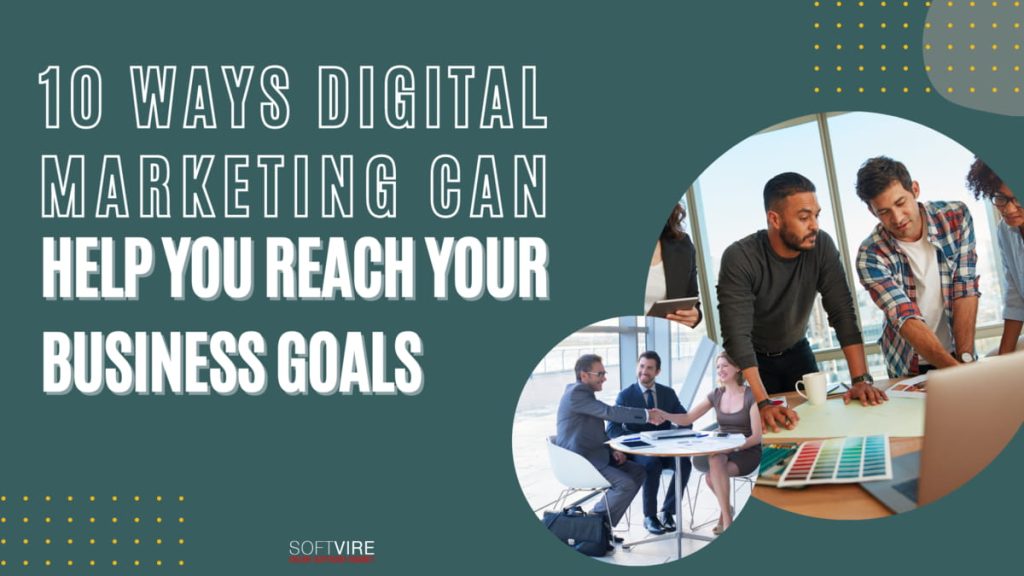In today’s interconnected world, digital marketing has emerged as a cornerstone for businesses aiming to thrive and succeed in the competitive market. Leveraging various online platforms and tools, digital marketing offers many ways to achieve diverse business objectives. From bolstering brand visibility to nurturing customer relationships and driving sales, the power of digital marketing lies in its versatility and adaptability.

Let’s explore how ten critical aspects of digital marketing can be harnessed to propel businesses toward their goals.
1. Increased Brand Visibility
Increased brand visibility is a cornerstone of successful digital marketing. It encompasses various strategies and channels that aim to enhance a brand’s presence in the digital realm. Here’s an in-depth look:
- Multi-Channel Approach: Digital marketing uses many different media and platforms, such as email marketing, social media, influencer relationships, search engines, and more. Each channel offers a unique way to reach and engage with potential customers. For example, other social media platforms like Facebook, Instagram, Twitter, and LinkedIn provide a dynamic space to interact, share content, and build brand personality. Meanwhile, search engine optimization (SEO) enables brands to be more visible in search results, increasing their visibility to users actively seeking their products or services.
- Targeting the Right Audience: Digital marketing allows for precise targeting. Understanding the audience’s demographics, interests, behaviors, and preferences allows for tailor-made marketing campaigns. This precision ensures that the brand’s visibility efforts are directed towards those most likely to become customers.
- Building Credibility and Trust: Consistent and meaningful visibility helps build credibility. When a brand consistently shows up in the spaces where its audience spends time, it creates a sense of trust and reliability. Continuous visibility leads to familiarity, which often translates into confidence and loyalty.
2. Targeted Advertising
Targeted advertising is a sophisticated facet of digital marketing that operates on data-driven precision to ensure that marketing efforts resonate with the most relevant audience. Here’s a deeper look into its mechanics:
- Optimizing Ad Spend: Targeted advertising minimizes wasted ad spend by displaying ads to those most likely interested in the product or service. This efficiency prevents resources from being squandered on audiences unlikely to convert, optimizing the return on investment (ROI).
- Dynamic and Continuous Optimization: The beauty of targeted advertising in the digital space is its adaptability. Data analysis allows for the constant optimization of ad campaigns in real-time. Somebody can adjust swiftly to ensure better resonance if a particular ad isn’t performing well with a specific segment.
- Building Customer Relationships: Effective targeting fosters a sense of understanding and connection with the audience. By consistently delivering relevant messages, brands can establish a rapport with their audience, leading to long-term relationships and customer loyalty.
3. Cost-Effectiveness
Cost-effectiveness is a pivotal advantage of digital marketing, granting businesses, especially smaller ones with limited budgets, the opportunity to compete on a more level playing field with larger enterprises. Here’s a deeper dive into this aspect:
- Lower Barrier to Entry: Digital marketing, compared to traditional methods like TV, radio, or print advertising, generally demands a lower financial barrier to entry. Platforms like social media, content marketing, email campaigns, and SEO allow businesses to promote their products or services without the hefty price tags associated with traditional advertising channels.
- Flexible Budget Allocation: Budget allocation has excellent flexibility in the digital realm. Businesses can start small and moderately increase their investment as they see results. This adaptability allows for optimizing spending based on campaign performance, ensuring more efficient resource utilization.
- Targeted Spending: Digital marketing offers the advantage of targeted spending. Businesses can allocate their budget specifically to reach their desired audience. This focused spending ensures that resources are utilized to get those most likely to convert, optimizing the return on investment.
4. Measurable Results
Measurable results in digital marketing are a game-changer, providing businesses with unprecedented access to data and analytics that enable them to decide with knowledge and optimize their strategies effectively. Here’s a closer look at this pivotal aspect:
- Real-Time Analytics: One of the critical strengths of digital marketing is the accessibility of real-time analytics tools. These tools provide instant insights into how campaigns are performing. Metrics like website traffic, click-through rates, conversion rates, and social media engagement are constantly monitored and updated, enabling immediate analysis.
- Campaign Performance Tracking: These analytics tools allow for the comprehensive tracking of various aspects of a campaign. Businesses can monitor the performance of specific ads, emails, or social media posts. They can identify which content resonates with the audience, which channels perform best, and where improvements are needed.
- Data-Driven Insights: The data obtained from these analytics provide actionable insights. By analyzing this information, businesses gain a deep understanding of their audience’s behavior, preferences, and interactions. This insight helps make data-driven decisions, optimize strategies, and focus on what works best.
5. Enhanced Customer Engagement
Enhanced customer engagement in digital marketing builds relationships, fosters connections, and nurtures loyalty. Here’s an in-depth exploration of this crucial aspect:
- Direct Interaction: Platforms like social media, email, live chat, and forums provide direct and immediate customer interaction. This direct line of communication authorizes businesses to respond to queries, feedback, and comments in real-time, fostering a sense of accessibility and responsiveness.
- Building Community: Social media platforms, in particular, facilitate the creation of communities around brands. Businesses can create groups, host discussions, or share user-generated content, allowing customers to engage with the brand and each other. This sense of belonging contributes to increased loyalty and advocacy.
- Rewarding Loyalty and Advocacy: Loyal customers often become brand advocates. Reward programs, exclusive offers, or simply recognizing and appreciating loyal customers through social media or email can further deepen their connection with the brand.
6. Global Reach
Global reach in digital marketing revolutionizes a business’s ability to transcend physical boundaries and connect with a vast, worldwide audience. Here’s an in-depth look at this transformative aspect:
- Leveraging Search Engines and Social Media: Search engines and platforms are naturally global. Optimizing content and advertising on these platforms allows businesses to be discovered by a worldwide audience, regardless of location.
- Cost-Efficient International Marketing: Marketing to a global audience through digital channels can be significantly more cost-effective than traditional international marketing. The ability to target specific regions or demographics online reduces unnecessary spending on broad and less-targeted global campaigns.
- Market Expansion Opportunities: The global reach of digital marketing enables companies to grow into new markets and demographics. This expansion can be done incrementally, allowing firms to test the waters and adapt their strategies as they grow.
7. Improved Conversion Rates
improved conversion rates are the Holy Grail of digital marketing, achieved through various strategies that drive targeted traffic and encourage visitors to take desired actions on a website. Let’s delve into the mechanisms behind this:
- Search Engine Optimization (SEO): SEO optimizes a website’s content and structure to rank higher in search engine results. By targeting specific keywords relevant to the business, SEO helps drive organic traffic from users actively searching for related products or services. The relevance of this traffic increases the likelihood of conversions, as visitors are already interested in what the website offers.
- Targeted Traffic: SEO directs highly targeted website traffic when effectively implemented. This means that the users arriving on the site actively seek what the business provides, making them more likely to convert, whether purchasing, signing up for a newsletter, or engaging in any desired action.
- Compelling Content: Content marketing is pivotal in conversion rate optimization. Engaging, informative, and persuasive content attracts visitors and guides them through their buyer’s journey. Compelling content educates, builds trust, and persuades visitors to take action.
8. Personalization
Personalization in digital marketing is a strategy that involves tailoring content, messages and offers to match the specific needs, preferences, and behaviors of individual users. Here’s a deeper exploration of this pivotal aspect:
- Behavior-Based Personalization: It involves analyzing user behavior, such as past purchases, website interactions, search history, and the content they engage with. This information helps create tailored experiences, whether suggesting similar products, offering related content, or providing relevant recommendations.
- Personalized Recommendations: Recommender systems use algorithms to suggest products or content based on a user’s past interactions. For example, e-commerce platforms like Amazon use this to show “products you might like” based on previous purchases or searches.
- Loyalty and Customer Retention: Personalization plays a significant role in fostering customer loyalty. Users are more likely to return When they feel understood and catered to. Continuing personalized interactions contribute to ongoing engagement and loyalty.
9. Building Authority and Credibility
Building authority and credibility in digital marketing is about establishing an industry’s robust and trustworthy reputation by consistently delivering value, expertise, and reliability. Let’s explore this in more detail:
- Valuable Content Creation: Producing high-quality and valuable content is vital to building authority. This content can take various forms, such as blogs, videos, podcasts, webinars, etc. By providing information that educates, solves problems, or entertains, a business showcases its expertise and adds value to its audience’s lives.
- Consistency and Reliability: Consistency in delivering valuable content or services is vital. Regular updates and interactions with the audience through blogs, social media, or newsletters help maintain visibility and credibility—reliability in providing accurate information and solutions, further cementing trust.
- Networking and Collaboration: Building connections and collaborating with other respected figures or brands in the industry can further enhance a business’s credibility. This association can solidify trust among the audience by association with other reputable entities.
10. Adaptability and Flexibility
Adaptability and flexibility are essential characteristics of digital marketing, allowing businesses to respond swiftly to changing circumstances and market trends. Here’s a more profound exploration:
- Trend Monitoring and Adaptation: Digital marketing allows businesses to monitor and adapt to current market trends and changes in consumer behavior. Companies can tweak their strategies to stay relevant and capitalize on new opportunities by visiting updates on emerging trends.
- Platform-Specific Adaptations: Different digital platforms have their own dynamics and best practices. For instance, strategies that work on social media might be less effective in email marketing. Digital marketers constantly adapt their content and approach to fit each platform’s requirements.
- Adapting to Consumer Preferences: Digital marketing allows businesses to adapt to changing consumer preferences. For instance, companies can quickly tailor their marketing efforts to highlight or incorporate these changes if a new feature or product becomes popular.
Conclusion
In an era where technology and connectedness are kings, digital marketing is essential to an organization’s expansion. Its diverse strategies, from targeted advertising to real-time analytics, offer a spectrum of opportunities for businesses to achieve their goals.
Ready to leverage the potency of digital marketing for your business? Whether expanding your brand’s reach, driving sales, or fostering customer loyalty, a well-crafted digital marketing strategy is your key to success. Consider consulting with experts or investing in resources to harness these digital avenues and propel your business toward its full potential. Embrace the digital realm and watch your business soar!
Author bio:
Genalyn Miranda is a resident writer and link builder for Softvire, an industry-leading Australian digital software provider. While doing her work, she also manages their E-Commerce business. Her commitment and enthusiasm towards the field of online business propelled her towards a professional trajectory in digital marketing.






